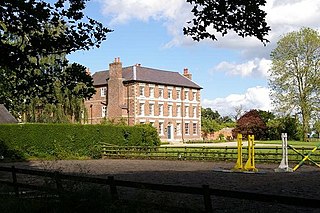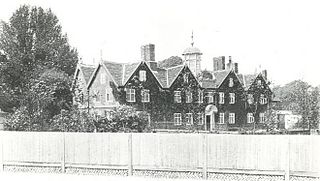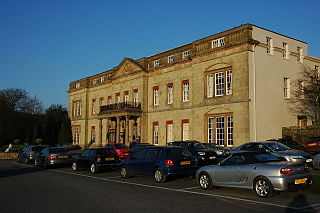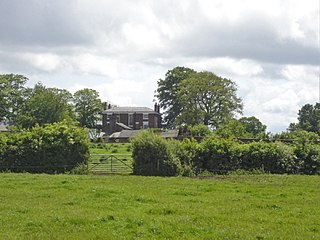
Pownall Hall is a former country house in Wilmslow, Cheshire, England. It was remodelled in 1830 as "a red sandstone Georgian house dressed up in the Tudor style". In 1886 it was bought by the Manchester brewer Henry Boddington, who transformed it "into a showcase for the most up-to-date work of the Arts and Crafts Movement". The architect was William Ball of the Ball and Elce partnership of Manchester. Much of the decoration and furniture design was carried out by members of the Century Guild, an organisation founded in 1882 by A. H. Mackmurdo. In addition "lots of pretty, small-scale bits of decoration" were added to the façade. The house is recorded in the National Heritage List for England as a designated Grade II* listed building. As of 2011 the building is in use as a school.
Antrobus Hall is a country house in the village of Mobberley, Cheshire, England. It was built in 1709, and a wing was added in about 1760. It was built for John Antrobus, a dissenter from Knutsford. The hall is constructed in brick, and has a stone-flagged roof. The house, together with its garden walls and gate piers, are recorded in the National Heritage List for England as a designated Grade II* listed building. The house has five bays on the ground floor, and four on its upper floor. The gate piers are rusticated.
Betchton Hall is a country house in the parish of Betchton, Cheshire, England. It was originally a timber-framed house, and was substantially rebuilt in brick in the 18th century for Richard Jackson, prebendary of Chester. In the early years of the following century it was extended for Richard Galley. The house is in two storeys. The southeast front has seven bays that include a round-headed doorway. The southwest front has three bays, and contains Venetian windows. The entrance hall is circular. In the house is an 18th-century fireplace moved from Faringdon House, then in Berkshire and now in Oxfordshire, in the 1960s. The house is recorded in the National Heritage List for England as a designated Grade II listed building.
Bexton Hall is a country house in the village of Bexton to the southwest of Knutsford, Cheshire, England. It is a square, symmetrical house of five bays, dating from the late 17th century. It is constructed in brick, with slate roofs, and has two storeys plus a basement. The house is recorded in the National Heritage List for England as a designated Grade II* listed building, and is the only listed building in Bexton parish. The forecourt walls are included in the listing. The house originally had a cupola, but this is no longer present.

Bulkeley Hall is a country house to the southwest of the village of Bulkeley, Cheshire, England. It dates from the middle of the 18th century, and was built for Thomas Bulkeley. The house is constructed in brick with a slate roof. Its architectural style is Georgian. The entrance front has three storeys, and is in seven bays. A service wing at right-angles gives it an L-shaped plan. The interior contains 18th-century plasterwork and joinery. The house is recorded in the National Heritage List for England as a designated Grade II* listed building.

Checkley Hall is a small country house in the parish of Checkley cum Wrinehill, Cheshire, England. The house was built in 1694 by the Delves family of Doddington, replacing an earlier timber-framed house. It was altered in the late 18th or early 19th century, replacing a hipped roof with an attic. The house is constructed in brick with a tiled roof. It has 2½ storeys, and an entrance front with five bays. The house is recorded in the National Heritage List for England as a designated Grade II* listed building. Its gate piers are listed at Grade II.

Dukenfield Hall is a country house located between Knutsford and Mobberley in Cheshire, England.

Hassall Hall is a former manor house to the east of the village of Hassall, Cheshire, England. The house dates from the 17th century, and was re-fronted in the 19th century. It has since been divided into two houses. It is constructed in rendered brick and has a slate roof. The house has an H-plan. The entrance front is symmetrical, in two storeys, with five bays. The central three bays are recessed and the middle bay contains a doorway. The doorway is flanked by Tuscan pillars, and above the door is an open pediment enclosing a fanlight. The houses are recorded in the National Heritage List for England as a designated Grade II* listed building.

Hawthorn Hall is a former country house in Hall Road, Wilmslow, Cheshire, England. It originated in about 1610 as a timber-framed yeoman house for John Chavman of mnc. It was improved and encased in brick for John Leigh in 1698. Its use changed in the 19th century, and in 1835 it opened as a homeless shelter school. The building has since been used as offices. It is constructed in plum-coloured brick, with a Kerridge stone-slate roof, a stone ridge, and three brick chimneys. Parts of the timber-framing can still be seen in the roof gables, and in an internal wall. The plan consists of a long rectangle. The house is in 2½ storeys, and has a near-symmetrical north front. There are four gables with bargeboards and mace finials. Each gable contains a pair of wooden mullioned and transomed windows. In the centre is a doorway, flanked by plain pilasters, and surmounted by a segmental hood framing a cartouche containing the date 1698. At the top of the hall, above the door, is a small balustrade, behind which is a half-glazed lantern with a cupola and a weathervane. The south front is similar to the north front, although the door is not central. This door is flanked by fluted pilasters, and surmounted by a plaque with a lion rampant. The east front has two gables. The architectural historian Nikolaus Pevsner comments that the house is "good to look at, though conservative for its date". The house, together with parts of the garden walls, is recorded in the National Heritage List for England as a designated Grade II* listed building.

Holford Hall is a country house west of the village of Plumley, Cheshire, England. It consists of a fragment of a much larger timber-framed house, built in 1601 for Mary Cholmondeley on a moated site. Part of the building was demolished in the 1880s. The house is timber-framed with rendered infill. It has a stone-slate roof. The entrance front has two bays with gables and Ionic pilasters. The architectural historian Nikolaus Pevsner describes this front as being "highly decorated". The house is recorded in the National Heritage List for England as a designated Grade II* listed building. The stone bridge leading to the house across the moat is listed at Grade II, and the moated site on which the house stands is a scheduled monument.

Lea Hall is a former country house standing to the northwest of the village of Wimboldsley, Cheshire, England. It dates from the early part of the 18th century, and was built for the Lowndes family. During the 19th century the house was owned by Joseph Verdin. Additions, including dormer windows, were made in the 19th century. During the 20th century the house was divided into three flats. The house is constructed in red brick with ashlar dressings and a tiled roof. It is in two storeys, with an attic and a basement. The roof is large and hipped, with a viewing platform. The entrance front is symmetrical, in five bays, the central bay protruding slightly forward. This bay contains a doorway with a swan's nest pediment decorated with scrolls, and containing a crest with the initials J V. The authors of the Buildings of England series describe the house as a "perfect brick box, delightful if just a little funny to look at". It is recorded in the National Heritage List for England as a designated Grade II* listed building.

Norley Hall is a country house in the village of Norley, Cheshire, England. It was built in about 1500 on the site of an earlier house for the Hall family, enlarged in 1697 for John Hall, rebuilt in 1782 for William Hall, and enlarged again in about 1845 for Samuel Woodhouse, giving it a Tudor appearance. The architect responsible for this latest enlargement was Alfred Bowyer Clayton. The service wing was extended later in the 19th century, and further additions and alterations were carried out during the 20th century, including the division of the building into two houses. The gardens were designed by Edward Kemp. The house is rendered, and has a sandstone ashlar basement, porch and dressings. The roofs are slated. Its plan is irregular. The main block is in two storeys, plus an attic and a basement. On the entrance front is a projecting central gabled bay. There is a single-storey porch with buttresses, pinnacles, a pierced balustrade, and a Tudor arched doorway. On the left side of the house is an octagonal stair turret surmounted by a bellcote with a conical roof. The service wing also has two storeys. The house is recorded in the National Heritage List for England as a designated Grade II listed building.

Overton Hall is a country house in the parish of Malpas, Cheshire, England. The house originated in the middle of the 16th century on a moated site as a timber-framed great hall with a screens passage; it was built for the Alport family. The great hall has since been divided into two floors, and the house was externally refaced in the early 19th century by the Gregson family. Two of the faces of the house are timber-framed with painted brick nogging. The other faces are in brick with stone dressings. The roofs are slated with tiles on the ridges. The chimney stacks, porch and bay windows are in stone. The house is recorded in the National Heritage List for England as a designated Grade II listed building. To the south of the house is a stone bridge over the former moat dating from the 18th century. This is also listed at Grade II. Immediately to the east of the hall are the remains of a medieval and post-medieval settlement and field system that are recognised as a Scheduled Monument.

Shrigley Hall is a former country house standing to the northwest of the village of Pott Shrigley, Cheshire, England. It has since been used as a school, when a chapel was added, and later as a hotel and country club operated by The Hotel Collection.

Stanthorne Hall is a country house standing to the west of the village of Stanthorne, Cheshire, England. It was built between 1804 and 1807 for Richard Dutton, who had purchased the estate from the Leicesters of Tabley. The house is constructed in brick with painted stone dressings and a slate roof. It is in three storeys with a symmetrical entrance front of three bays. The doorway is surrounded by Tuscan columns and an open pediment with a fanlight. The windows are sash windows. To the rear is a long wing. Inside the house, the entrance hall contains an open well staircase of three flights, and has a cornice with a frieze containing triglyphs. Two of the ground floor rooms have black marble fireplaces. The house is recorded in the National Heritage List for England as a designated Grade II listed building.

Stretton Hall is a country house in the parish of Stretton in Shropshire, England. It was built in about 1763 for John Leche. The house is constructed in brick on a sandstone basement, with painted stone dressings, and a slate roof. It has three symmetrical elevations. The entrance front is in three two-storey bays with a single-storey wing on each side. The central bay is canted, with five steps leading up to a doorway with a pediment. The windows are sashes. The garden front has similar windows, other than the wings, each of which contains a Venetian window. To the right of the house is attached a further wing, converted from the 17th-century stable of an earlier house. The house and former stable area is recorded in the National Heritage List for England as a designated Grade II* listed building. The sandstone garden walls are listed at Grade II.
Swettenham Hall is a country house standing to the southeast of the village of Swettenham, Cheshire, England. It dates from the 17th century and was remodelled in the 19th century. The house is constructed in pebbledashed brick on a stone plinth with a slate roof. It has a symmetrical façade in seven bays. The central bay has a single-storey canted bay window, and the second and sixth bays have two-storey canted bay windows. All the windows are sashes. At the rear of the house is a large three-bay canted bay window containing three pairs of French windows, above which are gables. The house is recorded in the National Heritage List for England as a designated Grade II listed building. Also listed at Grade II is a range of farm buildings to the east of the hall dating from the middle of the 18th century, and a private chapel to the northwest of the hall built in 1852.
Twemlow Hall is a country house standing on a former moated site in the parish of Twemlow, Cheshire, England. It dates from the 17th century, and was "much altered" in 1810 for William Bache Booth. It was altered again in 1974. The house is constructed in brick on a stone plinth. It has flush stone quoins and a slate roof. It has two storeys, and a symmetrical entrance front of five bays, three of which are gabled. Above the doorway are the arms of the Booth family. The windows are sashes. The house is recorded in the National Heritage List for England as a designated Grade II listed building. Three structures associated with the hall forming three sides of a former stable yard are also listed at Grade II.

Whirley Hall is a country house standing to the north of the village of Henbury, Cheshire, England. The house dates from about 1670. Additions and alterations were made during the 18th century and in the 1950s, when the house was restored and wings were added at the sides. The house is constructed in brick with buff sandstone dressings, and has a Kerridge stone-slate roof with stone ridges. It has three storeys and symmetrical five-bay front. Between the storeys, and above the top storey, are brick bands. The lower two storeys contain 20th-century wooden-framed mullioned and transomed windows. In the top storey are two-light casement windows. Above these are two shaped gables, each surmounted by an obelisk finial, and containing an elliptical window. There are single-storey, two-bay extensions on each side of the house. In the roof of the house is a stone inscribed with the date 1599, which is considered to have been removed from an earlier timber-framed house. The house is recorded in the National Heritage List for England as a designated Grade II* listed building. The gate pier in front of the house is a Grade II listed building.
Willot Hall is a country house in the parish of Prestbury, some 4.5 km to the east of Wilmslow, Cheshire, England. It originated as a medieval hall house in the later part of the 15th century. This was encased in stone in the 17th century. Later in the century a service wing was added. The house was restored and extended between 1933 and 1939, moving the entrance and reopening the great hall to the roof. It is constructed partly in buff sandstone rubble and partly in brick, with Kerridge stone slate roofs. It is in 2½ storeys, with a four-bay entrance front, the left bay being larger than the others. The left bay contains mullioned windows and is gabled. The other bays contain a doorway, smaller mullioned windows, and have gabled dormers. The house is recorded in the National Heritage List for England as a designated Grade II* listed building.














